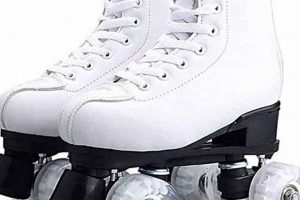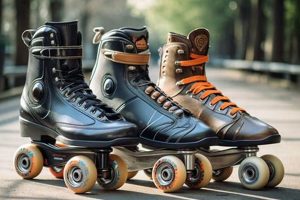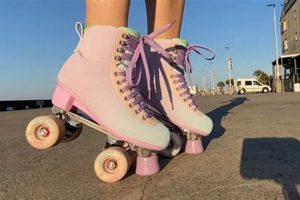Devices that combine the traditional roller skate form factor with electric motor propulsion offer a novel transportation and recreational option. These motorized skates integrate a battery, motor, and control system, often managed via a handheld remote or body movement, to provide powered movement. Individuals can experience an amplified skating experience, achieving greater speeds and traversing longer distances with reduced physical exertion compared to standard roller skates.
The development of such personal mobility devices addresses a growing need for efficient and enjoyable short-distance transport solutions. Advantages include enhanced maneuverability in urban environments, a reduced carbon footprint compared to larger vehicles, and the potential for recreational fitness. Historically, the evolution of skating technology has consistently sought to improve speed, control, and user convenience; electrically powered versions represent a significant advancement in this trajectory.
This discussion will now delve into the specifics of their design and functionality, exploring the technical components, safety considerations, legal regulations, and the potential future impact on personal transportation and recreational activities.
Operational and Maintenance Guidance
The following guidelines are intended to optimize performance and prolong the lifespan of electric personal mobility devices.
Tip 1: Battery Management. Adhere strictly to the manufacturer’s charging instructions. Overcharging or allowing the battery to fully deplete can significantly reduce its capacity and operational life. Implement a consistent charging schedule and store the device in a temperature-controlled environment when not in use.
Tip 2: Pre-Ride Inspection. Before each use, conduct a thorough inspection of all mechanical and electrical components. Verify the integrity of the wheels, bearings, brakes (if equipped), and wiring. Address any loose fasteners or signs of wear and tear promptly to prevent malfunctions during operation.
Tip 3: Surface Selection. Exercise caution when selecting surfaces for operation. Avoid uneven terrain, gravel, and areas with excessive moisture. Operating on smooth, dry surfaces minimizes the risk of falls and damage to the device’s components.
Tip 4: Protective Gear. Always wear appropriate protective gear, including a helmet, knee pads, elbow pads, and wrist guards. Impact protection is essential for mitigating injuries in the event of a fall.
Tip 5: Speed Control. Familiarize oneself with the device’s speed control mechanism and practice operating it in a safe, controlled environment. Gradually increase speed as proficiency increases and be mindful of surroundings.
Tip 6: Maintenance Schedule. Adhere to a regular maintenance schedule, including cleaning the wheels and bearings, lubricating moving parts, and inspecting the motor and battery connections. Refer to the manufacturer’s guidelines for specific maintenance procedures.
Tip 7: Legal Compliance. Be aware of and adhere to all local regulations regarding the use of these devices. This may include restrictions on where the devices can be used and whether specific licensing or registration is required.
Adhering to these recommendations will improve the safety, longevity, and overall experience when utilizing motorized personal mobility devices.
The subsequent sections will address common issues and troubleshooting techniques.
1. Motor Power
Motor power, measured in watts (W), stands as a critical determinant of the performance characteristics of motorized roller skates. It directly influences acceleration, top speed, and the ability to navigate inclines, shaping the overall user experience.
- Acceleration Capability
Higher motor power enables quicker acceleration, facilitating smoother starts and more responsive control. For instance, a skate with a 250W motor will accelerate slower than one with a 500W motor, impacting agility in traffic and the ability to react to obstacles. This directly correlates to user safety and control.
- Maximum Speed Attainment
The maximum speed achievable is fundamentally linked to motor power. A more powerful motor can overcome resistance and propel the user to higher speeds. Regulations often impose speed limits for these devices, and manufacturers must carefully balance power output with legal constraints and safety considerations. An overpowered motor could lead to dangerous speeds exceeding the user’s skill level or legal limits.
- Incline Negotiation
Motor power dictates the skate’s ability to ascend inclines. Steeper grades necessitate more power to maintain speed and prevent motor strain. A low-powered motor may struggle on even slight inclines, reducing usability in hilly terrain. Adequate power for incline negotiation enhances versatility and expands the environments where the skates can be effectively used.
- Thermal Management Implications
Greater motor power often correlates with increased heat generation. Efficient thermal management systems, such as heat sinks or active cooling, become crucial to prevent overheating and maintain optimal performance. Failure to adequately dissipate heat can lead to reduced motor lifespan and potential safety hazards.
In summary, motor power constitutes a fundamental parameter influencing the operational envelope of motorized roller skates. Selection must carefully consider user skill level, intended usage environment, and adherence to safety regulations to strike an appropriate balance between performance and user safety.
2. Battery Life
Battery life is a critical factor governing the practicality and utility of motorized roller skates. It defines the operational duration before recharging is necessary, directly influencing the distance a user can traverse and the overall convenience of the device. Insufficient battery life limits usage scenarios, potentially rendering the skates unsuitable for commuting or extended recreational use. Conversely, extended battery life enhances user freedom and reduces the frequency of interruptions for charging.
The capacity of the battery, typically measured in Watt-hours (Wh), directly correlates with the potential range. For instance, a skate equipped with a 150Wh battery may offer a range of approximately 10 miles, while a 300Wh battery could extend the range to 20 miles, assuming similar riding conditions and user weight. Environmental factors, such as terrain and temperature, also impact battery performance. Uphill riding and cold weather can reduce battery life, while smooth, flat surfaces and moderate temperatures tend to optimize it. Battery chemistry, such as Lithium-ion or Lithium-polymer, further influences energy density, discharge rate, and overall lifespan.
Optimizing battery life involves careful consideration of battery chemistry, capacity, and efficient power management. Users should adhere to manufacturer recommendations for charging and storage to maximize battery longevity. Advancements in battery technology continue to improve energy density and reduce charging times, enhancing the appeal and practicality of motorized roller skates as a viable transportation alternative. Understanding the interplay between battery characteristics and usage patterns is essential for making informed purchasing decisions and ensuring a satisfactory user experience.
3. Control Systems
The efficacy of electric roller skates is critically dependent on their control systems, which dictate the user’s ability to modulate speed, direction, and braking. These systems represent the interface between the user’s intent and the device’s mechanical operation. A well-designed control system facilitates intuitive and precise maneuvering, enhancing safety and overall user experience. Conversely, a poorly designed system can lead to unpredictable behavior, increasing the risk of accidents. For example, a system with excessive latency between input and motor response can create difficulty in maintaining balance and executing precise turns, while one lacking fine-grained control over speed can hinder navigation in crowded environments. The reliability and responsiveness of these control mechanisms are therefore paramount.
Control systems often employ a combination of sensors, microcontrollers, and actuators to translate user commands into corresponding motor actions. Handheld remotes, inertial measurement units (IMUs), or even gesture recognition systems can serve as input devices, providing the user with a means to communicate their desired actions to the skate’s central processing unit. The microcontroller then interprets these inputs and regulates the motor’s speed and direction via electronic speed controllers (ESCs). Furthermore, advanced control algorithms can incorporate feedback from sensors monitoring wheel speed, motor current, and battery voltage to optimize performance and prevent system failures. Consider the case of an emergency braking system: sensors detect sudden deceleration and activate the brakes, preventing potential collisions.
In summary, the control system is an indispensable element in electric roller skate design. Its effectiveness directly determines the safety, usability, and performance of the device. Continuous advancements in sensor technology, microcontrollers, and control algorithms promise further enhancements in the responsiveness, precision, and reliability of these systems, potentially unlocking new applications and expanding the appeal of electric roller skates as a personal mobility solution. Challenges remain in optimizing control systems for diverse user skill levels and environmental conditions while ensuring robustness and fail-safe operation.
4. Wheel Material
The selection of wheel material significantly influences the performance, safety, and durability of electric roller skates. It affects grip, rolling resistance, vibration absorption, and wear characteristics, directly impacting the user experience and the longevity of the device.
- Grip and Traction
Wheel material dictates the amount of grip and traction available on various surfaces. Polyurethane (PU) is a common choice due to its balance of grip and durability. Softer PU formulations offer enhanced grip on smooth surfaces, improving control and maneuverability. Conversely, harder PU compounds provide reduced rolling resistance for increased speed, but may sacrifice grip on slick or uneven surfaces. Inadequate grip can lead to loss of control, particularly during braking or turning maneuvers.
- Rolling Resistance
Rolling resistance affects the energy efficiency and maximum speed of the skate. Lower rolling resistance allows for greater speed with less motor power, extending battery life. Harder wheel materials generally exhibit lower rolling resistance, but may transmit more vibrations to the user. The trade-off between rolling resistance and grip must be carefully considered based on the intended application and riding conditions.
- Vibration Absorption
The ability of the wheel material to absorb vibrations contributes to ride comfort. Softer materials provide better vibration damping, reducing fatigue and improving control on rough surfaces. However, excessive softness can compromise responsiveness and increase energy loss due to deformation. The durometer (hardness) of the wheel material is a key factor in determining its vibration absorption characteristics.
- Durability and Wear
Wheel material affects the lifespan of the wheels and the frequency of replacement. Durable materials, such as high-quality PU compounds, resist abrasion and wear, extending the time between replacements. Factors such as surface conditions, riding style, and user weight contribute to wheel wear. Selecting a material appropriate for the intended use minimizes maintenance and ensures consistent performance.
In conclusion, the selection of wheel material is a critical engineering decision impacting the performance, safety, and longevity of electric roller skates. Balancing grip, rolling resistance, vibration absorption, and durability is essential to optimizing the user experience and ensuring the device’s suitability for its intended application.
5. Safety Features
The integration of safety features into electrically powered roller skates is paramount due to the increased speeds and potential hazards associated with motorized operation. These features mitigate risks of injury resulting from falls, collisions, or mechanical failures, addressing the inherent vulnerabilities of users who are typically unprotected and exposed to external environments. A direct causal relationship exists between the presence of robust safety mechanisms and the reduction in accident severity, thereby enhancing user confidence and promoting broader adoption of the technology. For instance, the implementation of responsive braking systems directly decreases stopping distances, minimizing the likelihood of collisions with pedestrians or objects.
Effective safety feature design requires a multi-faceted approach, encompassing active and passive safety measures. Active systems, such as anti-lock braking and dynamic stability control, intervene directly to prevent accidents by optimizing vehicle dynamics and maintaining control under adverse conditions. Passive systems, including reinforced frames and impact-absorbing materials, minimize injury severity in the event of a crash. The practical significance of this understanding is evident in the stringent safety standards imposed by regulatory bodies, which mandate specific safety requirements to ensure consumer protection. Products that adhere to these standards demonstrate a commitment to user safety and gain a competitive advantage in the marketplace.
In summary, safety features are not merely optional additions to electrically powered roller skates, but rather integral components essential for responsible product design and user well-being. Challenges remain in balancing safety enhancements with performance considerations and cost constraints. Continuous innovation and rigorous testing are necessary to address evolving safety concerns and realize the full potential of this emerging mode of personal transportation.
6. Regulatory Compliance
Regulatory compliance constitutes a critical aspect in the design, manufacturing, and operation of electric roller skates. Governmental bodies establish standards and regulations to ensure product safety, user protection, and adherence to public infrastructure usage guidelines. These regulations directly impact the design, functionality, and marketing of these devices.
- Safety Standards and Certification
Electric roller skates must meet specific safety standards, often requiring certification from accredited testing laboratories. These standards typically address electrical safety, battery safety, mechanical integrity, and braking performance. Compliance ensures that the device undergoes rigorous testing to minimize risks of electrical shock, fire hazards, structural failures, and uncontrolled acceleration. Failure to obtain necessary certifications can result in product recalls, legal liabilities, and market access restrictions.
- Speed and Power Limitations
Many jurisdictions impose limits on the maximum speed and motor power of electric personal mobility devices, including roller skates. These restrictions aim to balance user enjoyment with public safety, preventing excessive speeds that could endanger pedestrians or cyclists. Regulatory bodies may define speed limits based on location (e.g., pedestrian zones, bike paths) and require devices to be equipped with speed governors or indicators. Non-compliance can result in fines, confiscation of the device, and legal penalties.
- Operational Restrictions and Licensing
Regulations may restrict the areas where electric roller skates can be operated, such as prohibiting their use on sidewalks, highways, or designated pedestrian zones. Some jurisdictions may require users to obtain licenses or permits to operate these devices legally, particularly if they exceed certain speed or power thresholds. These requirements aim to ensure that users are aware of traffic laws and responsible operation practices. Enforcement mechanisms may include fines, impoundment, and legal prosecution for violations.
- Product Labeling and Disclosure Requirements
Regulatory agencies often mandate specific product labeling and disclosure requirements for electric roller skates. This includes providing clear information about the device’s specifications (e.g., voltage, battery capacity, maximum speed), safety precautions, warranty terms, and compliance certifications. Manufacturers must accurately represent the device’s capabilities and limitations to avoid misleading consumers. Failure to comply can result in regulatory penalties and reputational damage.
These facets of regulatory compliance collectively shape the landscape for electric roller skates, influencing product design, manufacturing practices, and user behavior. Adherence to these regulations is essential for ensuring product safety, minimizing legal risks, and promoting the responsible adoption of this emerging mode of personal transportation.
7. Portability
The inherent design of roller skates, traditionally emphasizing compact dimensions and relatively low weight, inherently suggests a degree of portability. The addition of electric motorization to this form factor, however, introduces complexities that directly impact this characteristic. Increased weight due to batteries and motors, as well as the potential for increased overall size, presents challenges to maintaining ease of transport and storage. The degree to which these challenges are overcome determines the practicality of the device for users who require multi-modal transportation or have limited storage space. Effective integration of components and judicious material selection are critical for maximizing portability without compromising performance or safety.
The influence of portability on user adoption is substantial. Consider an individual commuting to work who wishes to use electrically powered roller skates for a portion of their journey. If the skates are excessively bulky or heavy, carrying them on public transport or storing them in a small office becomes impractical. Conversely, if the skates can be easily folded, compacted, or otherwise made more manageable for transport, they become a more appealing and viable option. The design of carrying cases, handles, and other features that facilitate transport and storage are also vital. A practical example would be designs that incorporate easily removable batteries that both reduce weight for carrying and allow for separate charging.
In summary, portability remains a significant factor in the viability of electrically powered roller skates as a personal transportation solution. Design choices that prioritize compactness, lightweight construction, and ease of handling directly influence user convenience and the potential for widespread adoption. While the integration of electric components inevitably adds bulk, innovative design approaches can mitigate these challenges and maintain a satisfactory level of portability. Future development will likely focus on further reducing weight and improving form factors to enhance the device’s appeal to urban commuters and recreational users alike.
Frequently Asked Questions About Electric Roller Skates
The following questions address common inquiries and misconceptions regarding electric roller skates, providing concise and factual information.
Question 1: What is the typical range achievable on a single charge?
The range varies significantly based on battery capacity, rider weight, terrain, and speed. Most models offer a range between 8 and 15 miles under optimal conditions. Real-world range may be lower due to inclines and varying surface conditions.
Question 2: What safety precautions are necessary when operating electric roller skates?
Wearing appropriate protective gear, including a helmet, knee pads, elbow pads, and wrist guards, is crucial. Operating the device in designated areas, avoiding traffic, and maintaining a safe speed are also essential.
Question 3: Are electric roller skates legal to use on public streets and sidewalks?
Legality varies by jurisdiction. Many areas have specific regulations regarding the use of electric personal mobility devices on public thoroughfares. It is imperative to consult local laws and ordinances before operating electric roller skates in public spaces.
Question 4: What is the average lifespan of an electric roller skate’s battery?
The battery lifespan is contingent upon usage patterns and maintenance. Under typical conditions, a quality lithium-ion battery should provide between 300 and 500 charge cycles before experiencing a significant reduction in capacity. Following manufacturer recommendations for charging and storage is crucial.
Question 5: What maintenance is required to keep electric roller skates in optimal condition?
Regular cleaning, inspection of mechanical components, lubrication of bearings, and proper battery care are essential. Check for loose fasteners, worn wheels, and damaged wiring. Consulting the manufacturer’s maintenance guidelines is highly recommended.
Question 6: What is the typical cost of electric roller skates?
The cost varies depending on features, battery capacity, motor power, and brand. Entry-level models may start around $300, while high-end models can exceed $1000. Price does not always reflect quality or performance, therefore researching thoroughly to make your decision is imperative.
Electric roller skates present a novel transportation option, but require careful consideration of safety, legality, and maintenance. Informed decision-making is paramount for a positive user experience.
The subsequent discussion will delve into the potential environmental impact of electric roller skates compared to alternative transportation modes.
Conclusion
This exploration has examined the multifaceted aspects of electric roller skate devices, from their operational mechanics and battery technology to safety considerations, regulatory constraints, and impact on user portability. The discussion underscores the inherent trade-offs between performance characteristics, safety features, and design choices that influence the practicality and appeal of these emerging personal transportation devices. These considerations are critical for both manufacturers and consumers to achieve a balance between technological advancement and responsible usage.
The future trajectory of electric roller skate technology will depend on continued innovation in battery efficiency, motor miniaturization, and control system responsiveness. However, the ultimate success of this transportation modality hinges upon proactive engagement with regulatory frameworks and a commitment to prioritizing user safety through responsible design and operation. Further research and development, combined with informed consumer awareness, will dictate the extent to which these devices can sustainably integrate into the evolving landscape of personal mobility.







